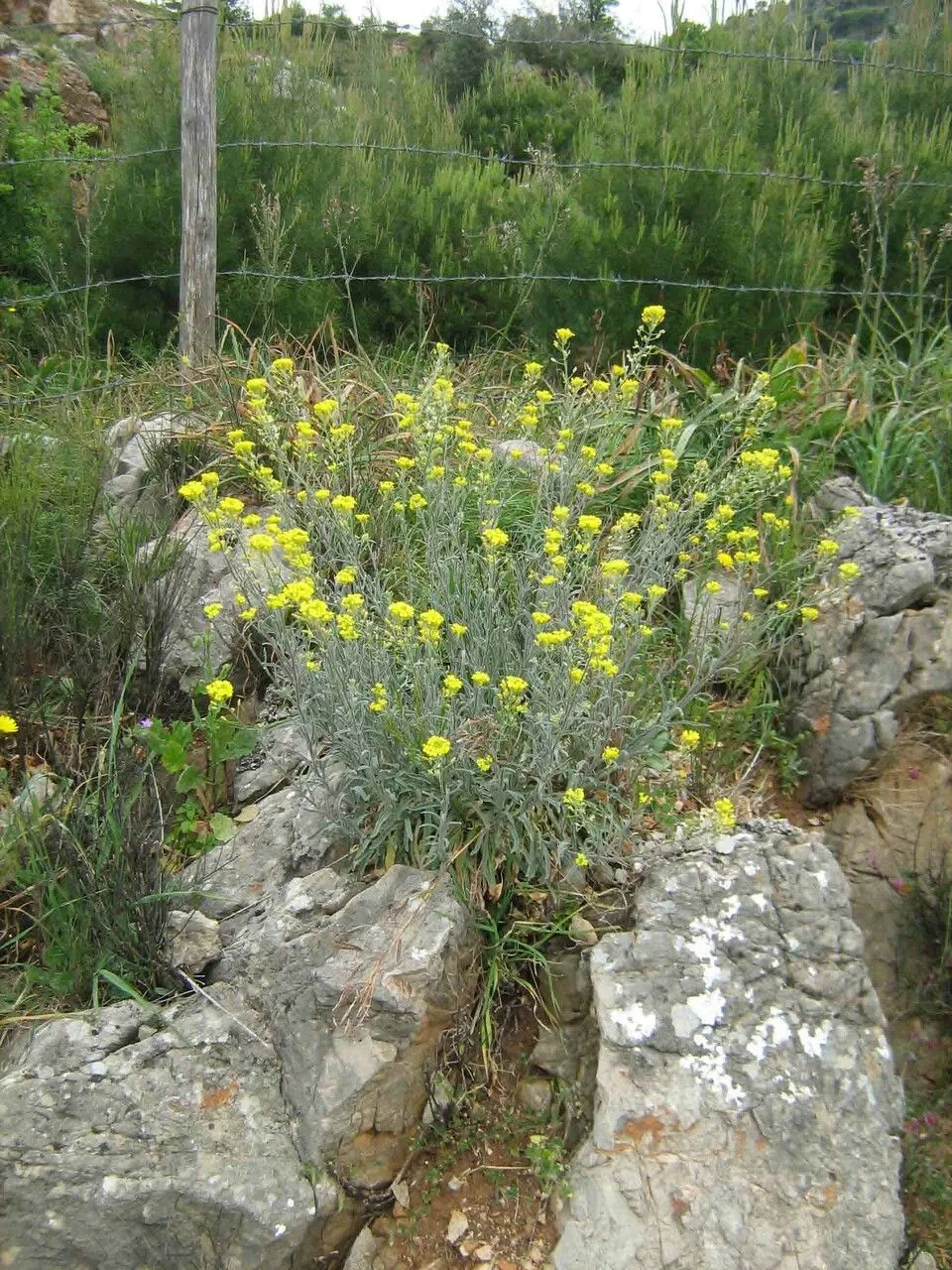
Author: L.
Bibliography: Sp. pl. 2:650. 1753, nom. cons. prop.
Year: 1753
Status: accepted
Rank: species
Genus: Alyssum
Vegetable: False
Observations: France to SW. Germany
Mountain Alison (Alyssum montanum) is a perennial plant species belonging to the Brassicaceae family. This delightful and hardy plant showcases the resilient beauty of nature, flourishing particularly in rocky and mountainous terrains.
Mountain Alison typically forms low-growing mat-like spreads, often growing to a height of about 10-15 centimeters. The plant is characterized by its small, grey-green leaves that create a dense foliage, providing a verdant backdrop to its vivid yellow flowers. These blossoms, which appear in clusters, are known for their bright and cheerful hue, creating a striking contrast against the plant’s foliage.
Mountain Alison is predominantly found in regions spanning from France to southwestern Germany. It thrives in dry, rocky environments and is well-adapted to surviving with minimal soil nutrients, making it a common sight in mountainous and alpine areas within its range.
First described in the mid-18th century, Mountain Alison’s scientific classification by Linnaeus is documented in “Species Plantarum” (Sp. pl. 2:650, 1753, nom. cons. prop.). This classification underlines its longstanding recognition in botanical literature and its conservation as a distinct species.
This species is favored in rock gardens and as ground cover due to its hardiness and ease of care. It requires well-drained soil and full sun to partial shade to thrive. Mountain Alison is tolerant of drought, making it an excellent choice for gardens in arid regions or for those seeking low-maintenance plants. Its ability to spread low to the ground helps in controlling soil erosion, making it not just an ornamental choice but also a functional one in garden landscaping.
Mountain Alison plays a crucial role in its native habitat by providing ground cover that protects against soil erosion. It also contributes to the local ecosystem, supporting various pollinators, including bees and butterflies, with its blossoms.
Mountain Alison (Alyssum montanum) is more than just a visually appealing plant. Its ability to thrive in less-than-ideal conditions, coupled with its ecological benefits, make it a valuable species within its native range and beyond. Whether employed in a cultivated garden setting or appreciated in the wild, Mountain Alison exemplifies resilience and the understated beauty of nature’s less obvious gems.
Deu: berg-steinkraut, berg-steinkraut i.w.s., gewöhnliche berg-steinkraut
Dan: liden krognål
Fra: alysse des montagnes
Swe: liten stenört
Eng: mountain alison
Nld: bergschildzaad
En: Mountain alison, Mountain Alyssum, Montain Alyssum
Ar: أليس جبلي
Az: Meşə çuğundurotu
Cs: Tařice horská
Da: Liden krognål
Nl: Bergschildzaad
Et: Gmelini kilbirohi
Fi: Rinnekilpiruoho
Fr: Alysse des montagnes, Alysson des montagnes, Passerage des montagnes, Alysse de montagne, Alysson de montagne, Alyssum des collines
De: Gewöhnliche Berg-Steinkraut, Berg-Steinkraut, Berg-Steinkraut i.w.S.
Hu: Hegyi ternye
It: Alisso montanino
Ko: 꽃냉이
Pl: Smagliczka pagórkowa
Sk: Tarica horská
Sv: Liten stenört
© copyright of the Board of Trustees of the Royal Botanic Gardens, Kew.
© copyright of the Board of Trustees of the Royal Botanic Gardens, Kew.
© copyright of the Board of Trustees of the Royal Botanic Gardens, Kew.
Taken Apr 2, 2021 by Lugifa Lugifa (cc-by-sa)
Taken Apr 15, 2021 by Llandrich anna (cc-by-sa)
Taken Jul 23, 2017 by huy HO (cc-by-sa)
Taken Apr 3, 2014 by Lugifa Lugifa (cc-by-sa)
Taken Apr 3, 2020 by Martin Martin (cc-by-sa)
Taken Apr 20, 2022 by Else Nolden (cc-by-sa)
Taken Feb 24, 2022 by Llandrich anna (cc-by-sa)
Taken Jan 1, 1800 by Tela Botanica − Thierry Pernot (cc-by-sa)
Taken Apr 15, 2021 by Llandrich anna (cc-by-sa)
Taken Apr 3, 2014 by Lugifa Lugifa (cc-by-sa)
Taken Apr 7, 2015 by Tela Botanica − Jean-Claude CALAIS (cc-by-sa)
Taken Apr 7, 2015 by Tela Botanica − Jean-Claude CALAIS (cc-by-sa)
Taken Jan 1, 1800 by Tela Botanica − Thierry Pernot (cc-by-sa)
Taken Apr 7, 2015 by Tela Botanica − Jean-Claude CALAIS (cc-by-sa)
Taken Apr 3, 2014 by Lugifa Lugifa (cc-by-sa)
Taken Feb 24, 2022 by Llandrich anna (cc-by-sa)
Taken May 21, 2021 by Jean-Luc Durand (cc-by-sa)
Taken May 9, 2021 by Frédérique Berato (cc-by-sa)
Taken Apr 2, 2021 by Lugifa Lugifa (cc-by-sa)
Taken Apr 15, 2021 by Llandrich anna (cc-by-sa)
Taken Jun 1, 2022 by nasrin norozi (cc-by-sa)
Taken Aug 1, 2016 by patrizi nando (cc-by-sa)
Taken Jan 1, 1800 by Tela Botanica − Thierry Pernot (cc-by-sa)
Taken Jul 23, 2017 by huy HO (cc-by-sa)
Taken Apr 15, 2021 by Llandrich anna (cc-by-sa)
Taken May 15, 2009 by Photoflora – Jean-Luc TASSET (©)
Taken Jan 1, 1970 by Photoflora – L’Abbé COSTE (©)
Taken May 24, 2017 by Tela Botanica − Jean Paul SAINT MARC (cc-by-sa)
Taken Jan 1, 1800 by Tela Botanica − Thierry Pernot (cc-by-sa)
Taken Jan 1, 1800 by Tela Botanica − Thierry Pernot (cc-by-sa)
Light: 9
Family: Myrtaceae Author: (F.Muell.) K.D.Hill & L.A.S.Johnson Bibliography: Telopea 6: 402 (1995) Year: 1995 Status:…
Family: Rubiaceae Author: Pierre ex A.Froehner Bibliography: Notizbl. Bot. Gart. Berlin-Dahlem 1: 237 (1897) Year:…
Family: Sapindaceae Author: Koidz. Bibliography: J. Coll. Sci. Imp. Univ. Tokyo 32(1): 38 (1911) Year:…
Family: Asteraceae Author: A.Gray Bibliography: Pacif. Railr. Rep.: 107 (1857) Year: 1857 Status: accepted Rank:…
Family: Fabaceae Author: Medik. Bibliography: Vorles. Churpfälz. Phys.-Ökon. Ges. 2: 398 (1787) Year: 1787 Status:…
Family: Aspleniaceae Author: (Cav.) Alston Bibliography: Bull. Misc. Inform. Kew 1932: 309 (1932) Year: 1932…